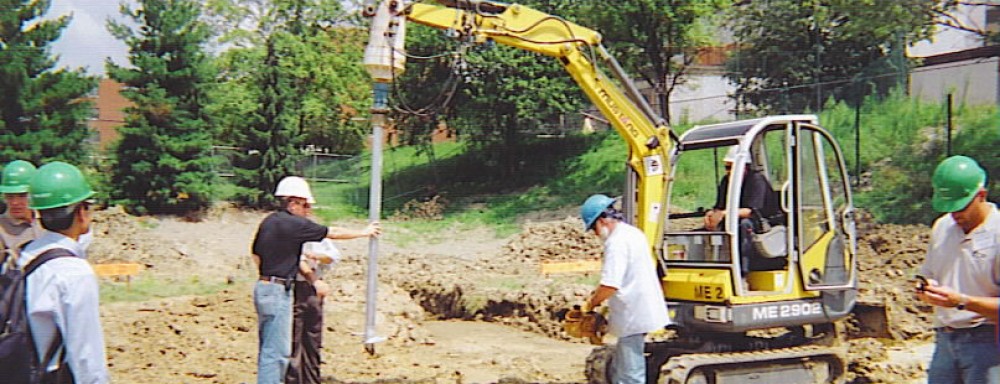There are still many engineers, architects, contractors and owners who are unfamiliar with Screw-Piles and Helical Anchors as a viable and economic alternative foundation and anchor system. To help remove some of the mystery surrounding the technology we have assembled some of the most Frequently Asked Questions (FAQs) regarding Screw-Piles and Helical Anchors and have attempted to provide concise answers that may help educate potential users.
Q 1. What is a Screw-Pile or Helical Anchor?
A1. A Screw-Pile is a round shaft open steel pipe pile with one or more helical plates welded to the pipe near the tip. The pile is installed by rotating the pipe shaft. As the shaft rotates, the helical plate advances into the ground “pulling” the pipe shaft with it. This action is much like a cork-screw. Some Screw-Piles have a square shaft that is surrounded by Portland Cement Grout (PCG). A Screw-Pile is generally used to resist compression and lateral loading.
A Helical Anchor differs from a Screw-Pile in that it usually consists of a square shaft with one or more helical plates welded to the shaft. The anchor is installed by rotating the shaft. As the shaft rotates, the helical plate advances into the ground. A Helical Anchor is generally used to resist tensile loading.
Q2. How do Screw-Piles and Helical Anchors actually work to resist loads?
A2. Screw-Piles provide resistance to load through a combination of side resistance along the pipe shaft, just like a traditional driven pipe pile, and end bearing developed by the helical plate. The amount of load taken by the shaft and the helical plate depends on the soils and the length and diameter of the shaft and the number and diameter of the helical plates.
A Helical Anchor generally only provides resistance to load through end bearing of the helical plates. The square shaft does not contribute to load capacity unless it is surrounded by PCG.
Q3. Is this technology new in the industry, I’ve never heard of it?
A3. No, it isn’t new. In fact, the technology has been around since the mid 1800s and was used extensively for about 60 years. It hasn’t been until about the last 25 years that we have seen a very dramatic resurgence in its use throughout the world, probably because we now have high capacity hydraulic torque motors to perform the installation.
Q4. What is the load capacity of Screw-Piles and Helical Anchors?
A4. The maximum load capacity of Screw-Piles and Helical Anchors is the lesser of the structural capacity of the steel section, the structural capacity of the connections between any shaft extensions, and the capacity of the soil. The load capacity available from the soil depends on soil strength and the geometry of the Screw-Pile or Helical Anchor, including size, type and length of the shaft, and the number, size and spacing of the helical plates. Usually, the strength of the soil controls load capacity.
Q5. How long does it take to install a Screw-Pile or Helical Anchor?
A5. Screw-Piles and Helical Anchors are installed using conventional construction equipment like skid-steers and track excavators equipped with a low speed, high torque, hydraulic torque motor. The motor is attached directly to the hydraulics of the machine. A typical rotation installation speed is about 8 to 10 revolutions per minute. With a typical helix pitch of 3 in., this means that it takes about 30 sec. to advance each 1 ft. of depth, so about 10 minutes for a 20 ft. installation. A few minutes are also needed to set up each location and add extensions if needed. The pile or anchor can be installed to almost any depth by adding additional shaft sections just like most other piles and anchors but cannot be used to penetrate large gravel, cobbles or bedrock.
Q6. How do I know if Screw-Piles or Helical Anchors are good choice for my project?
A6. There are a number of factors that should be considered that may make Screw-Piles or Helical Anchors a good choice of foundation or support system for your project. Screw-Piles and Helical Anchors are an excellent choice in sites where the ground water table is high and excavations can be a problem; sites where soft soils are near the surface and loads need to be transferred to a stronger deeper bearing strata; situations that need rapid response or where the construction schedule is short in which there may be no time to wait for concrete to setup; projects that have limited access or headroom or where adjacent structures are sensitive to vibrations or noise are also good candidates to consider the use of Screw-Piles or Helical Anchors.
Q7. How do I know which Screw-Pile or Helical Anchor to use for my project?
A7. Since there are a large variety of configurations of Screw-Piles and Helical Anchors available from many different manufacturers there are a number of different possibilities of Screw-Piles and Helical Anchors that might be selected for a given project. The final selection should be made by a Geotechnical Engineer who is familiar with this technology and who will consider the expected design loads of your project, the site stratigraphy and specific properties of each soil layer that may provide support.
Q8. How much will it cost to install Screw-Piles or Helical Anchors for my project?
A7. Cost depends on each project, but the cost of Screw-Piles and Helical Anchors is very competitive with other types of foundation and anchor systems. In many cases they may be more economical, especially when the cost of the actual foundation/anchor element and the cost of installation are combined. Since no special equipment needs to be mobilized, like a crane and pile hammer, the installation cost is more competitive than other types of foundations. Also, scheduling of installation is easy and site disruption is minimal so that the entire project schedule can move quickly. A cost analysis for foundation comparisons should be made in units of $ per ton of load capacity.
